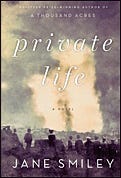Private Life is one of those exceptional historical novels whose relevance to our own time is especially powerful because its portrayal of the past is so seamlessly authentic. Margaret lives in the shadow of three wars. In her childhood, the Civil War's divisions remain alive in her rural Missouri community. During the First World War, her eccentric husband is an astronomer at the Naval Observatory in Vallejo, California. When the United States enters the Second World War, she discovers to her horror that choices she has made in her private life may have national consequences.
Though Margaret thinks of herself as ordinary, in rural Missouri she does not fit easily or gracefully into a woman's role. She is an avid reader, alight with curiosity, impatient with constricting conventions. Her first meeting with her future husband caps a glorious solitary outing on a borrowed bicycle. "To be balanced so precariously, and to feel that balance become steadier ... was exhilarating."
Andrew's undeniable brilliance is marred by his obsession with pet theories he furiously defends long after a more objective mind would recognize their flaws. Margaret begins to wonder whether his bitterness might be "in some sense an argument against education - wouldn't he have been happier with smaller thoughts? As an investor, he was a whiz. As an observer of nature ... he was exact and careful.... But day after day, year after year, he thought only of the universe, which he could not see." She becomes gifted at deflecting his fits of rage at scientists he imagines are conspiring to suppress his theories.
She will have occasion to recall her mother's advice: "You've always been a good girl, and now you've had a piece of luck, marrying at twenty-seven, but a wife only has to do as she's told for the first year." When Margaret realizes the profound importance of this advice, it is almost too late to put it into effect. (2010; 318 pages)




